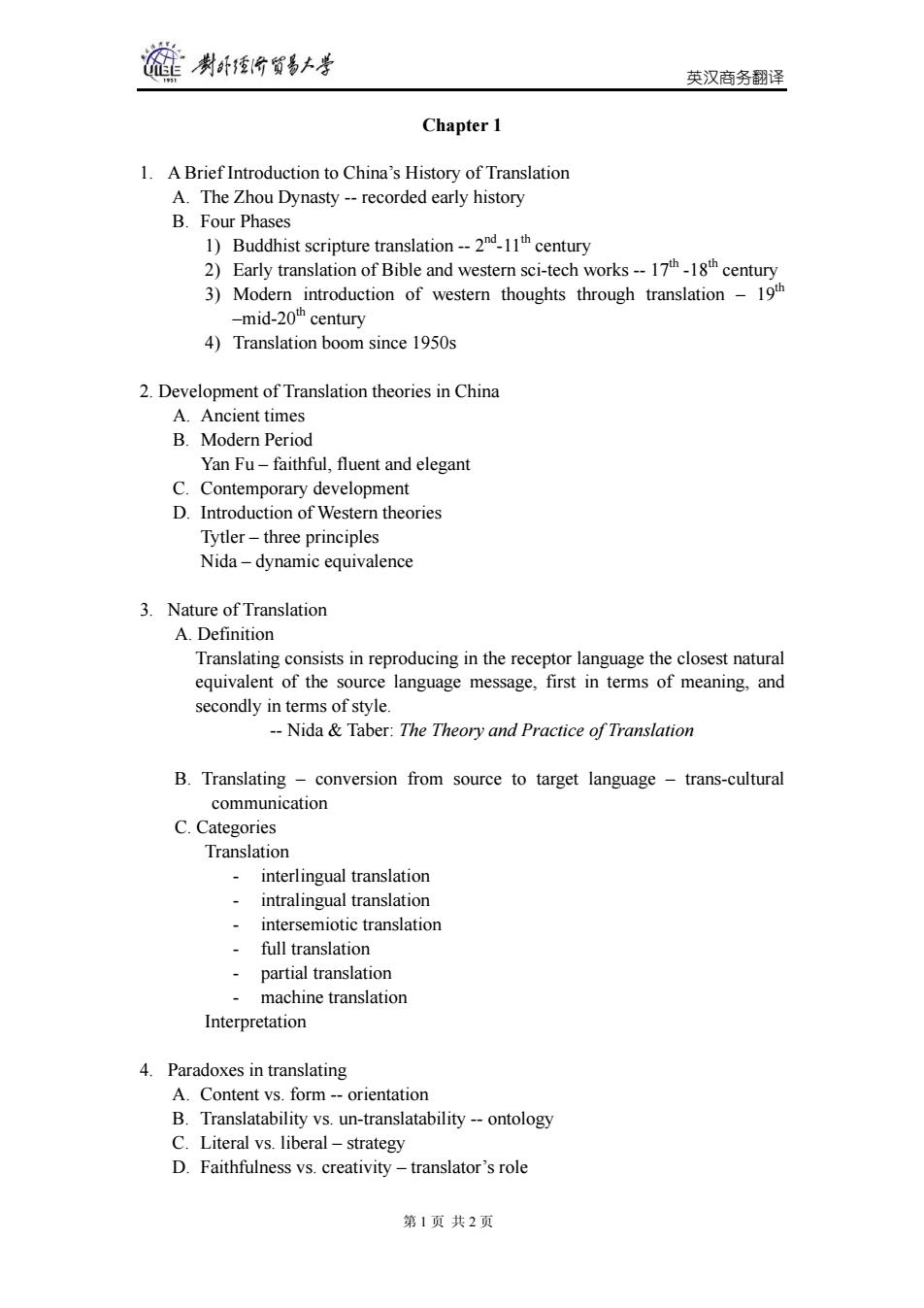
溢 制卧爱分贸多本考 英汉商务翻译 Chapter 1 1.A Brief Introduction to China's History of Translation A.The Zhou Dynasty--recorded early history B.Four Phases 1)Buddhist scripture translation-211 century 2)Early translation of Bible and western sci-tech works--17h-18th century 3)Modern introduction of western thoughts through translation-19th -mid-20曲century 4)Translation boom since 1950s 2.Development of Translation theories in China A.Ancient times B.Modern Period Yan Fu-faithful,fluent and elegant C.Contemporary development D.Introduction of Western theories Tytler-three principles Nida-dynamic equivalence 3.Nature of Translation A.Definition Translating consists in reproducing in the receptor language the closest natural equivalent of the source language message,first in terms of meaning,and secondly in terms of style. --Nida Taber:The Theory and Practice of Translation B.Translating -conversion from source to target language -trans-cultural communication C.Categories Translation interlingual translation intralingual translation intersemiotic translation full translation partial translation machine translation Interpretation 4.Paradoxes in translating A.Content vs.form--orientation B.Translatability vs.un-translatability--ontology C.Literal vs.liberal-strategy D.Faithfulness vs.creativity-translator's role 第1页共2页
英汉商务翻译 Chapter 1 1. A Brief Introduction to China’s History of Translation A. The Zhou Dynasty -- recorded early history B. Four Phases 1) Buddhist scripture translation -- 2nd-11th century 2) Early translation of Bible and western sci-tech works -- 17th -18th century 3) Modern introduction of western thoughts through translation – 19th –mid-20th century 4) Translation boom since 1950s 2. Development of Translation theories in China A. Ancient times B. Modern Period Yan Fu – faithful, fluent and elegant C. Contemporary development D. Introduction of Western theories Tytler – three principles Nida – dynamic equivalence 3. Nature of Translation A. Definition Translating consists in reproducing in the receptor language the closest natural equivalent of the source language message, first in terms of meaning, and secondly in terms of style. -- Nida & Taber: The Theory and Practice of Translation B. Translating – conversion from source to target language – trans-cultural communication C. Categories Translation - interlingual translation - intralingual translation - intersemiotic translation - full translation - partial translation - machine translation Interpretation 4. Paradoxes in translating A. Content vs. form -- orientation B. Translatability vs. un-translatability -- ontology C. Literal vs. liberal – strategy D. Faithfulness vs. creativity – translator’s role 第 1 页 共 2 页

莲 制卧台贸易上兰 英汉商务翻译 E.Science vs.art-translation studies Ex.1 After 12 months of the economic roller coaster,there were few signs of changing attitudes. 5.Criteria of Translation A.Tytler's 3 principles vs.Yan Fu's 3 tasks The translation should give a complete transcript of the ideas of the original work. The style and manner of writing should be of the same character with that of the original. The translation should have all the ease of original composition C.Fidelity Fluency D.Pluralistic standards E.Delivery of message,communicative functions and proper styles 第2页共2页
英汉商务翻译 E. Science vs. art – translation studies Ex. 1 After 12 months of the economic roller coaster, there were few signs of changing attitudes. 5. Criteria of Translation A. Tytler’s 3 principles vs. Yan Fu’s 3 tasks The translation should give a complete transcript of the ideas of the original work. The style and manner of writing should be of the same character with that of the original. The translation should have all the ease of original composition. C. Fidelity & Fluency D. Pluralistic standards E. Delivery of message, communicative functions and proper styles 第 2 页 共 2 页